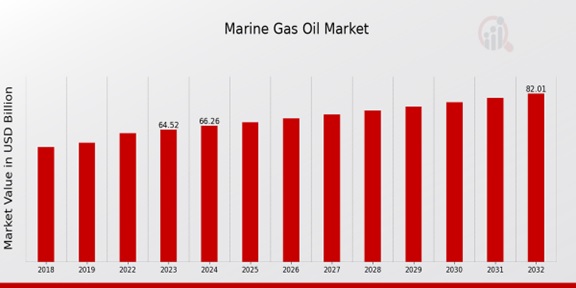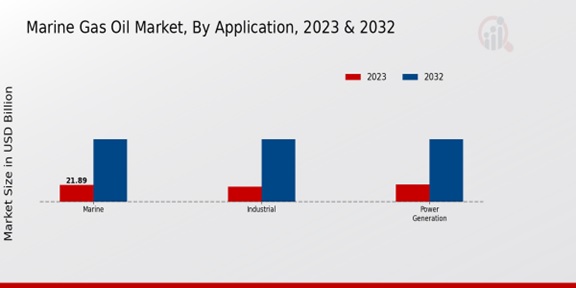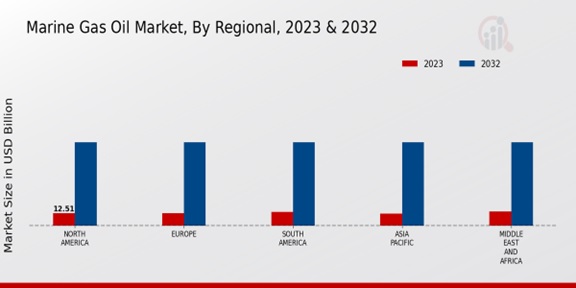Global Marine Gas Oil Market Overview
As per MRFR analysis, the Marine Gas Oil Market Size was estimated at 62.83 (USD Billion) in 2022. The Marine Gas Oil Market Industry is expected to grow from 64.52 (USD Billion) in 2023 to 82 (USD Billion) by 2032. The Marine Gas Oil Market CAGR (growth rate) is expected to be around 2.7% during the forecast period (2024 - 2032).
Key Marine Gas Oil Market Trends Highlighted
Key market drivers for Marine Gas Oil (MGO) include increasing demand from the global shipping industry, stringent environmental regulations, and the shift towards cleaner fuels. The growing adoption of IMO 2020 regulations, which limit sulfur content in marine fuels, has driven the demand for MGO as a compliant alternative.
Opportunities for growth in the MGO market lie in the expansion of the global shipping fleet, particularly in regions like Asia and Latin America, as well as the increasing adoption of eco-friendly shipping practices. The market is also expected to benefit from the growing use of MGO as a fuel for auxiliary generators and boilers on ships.
Recent trends in the MGO market include the rising popularity of biodiesel blends as a more sustainable fuel option, the development of new low-sulfur MGO grades, and the integration of advanced fuel management systems to optimize fuel efficiency.

Source: Primary Research, Secondary Research, MRFR Database and Analyst Review
Marine Gas Oil Market Drivers
-
Increasing Demand for Marine Transportation
The marine gas oil market is primarily growing because of the increasing demand for marine transportation. Globally, as trade is growing, the need for ships and other marine vessels is also increasing. Therefore, the demand for gas oil that serves a fuel for the boats is going up, as well. The trend is even more apparent in emerging economies, such as China and India, that are importing more and more goods daily. The increased demand for transported goods is sure to increase the demand for marine gas oil. Moreover, the products and raw materials are likely to be transported over greater distances in the future, further boosting the demand for vessels and MGO.
Altogether, these two factors should have a massive impact on the demand for MGO and cause the demand to go up, which would lead to an increasing demand for it over time. For these reasons, the increasing demand for marine transportation and the IMO 2020 rules are the two factors that are driving the growth of the marine gas oil market the most and are likely going to continue to drive the growth in the future, making the market potentially a good investment.
Rising Fuel Costs
The second major factor that drives the growth of the marine gas oil market is the rising cost of fuel. Over the past years, the cost of marine gas oil has been continuously growing for several reasons. The first reason is the growing demand for oil. The second reason is the geopolitical tensions in the Middle East. The third reason is the development of the economy in different countries all around the world. The rising cost of fuel results in increasing expenses on the operation of ships, raising the cost of shipping overall. This process leads to the increasing demand for marine gas oil. Ship operators attempt to find methods of decreasing the cost of fuel and making marine gas oil more in demand in the market. With the growing demand for oil around the world, the trends of the rising cost of fuel and increasing demand for marine gas oil will remain in the following years.
Technological Advancements
One of the key drivers of growth in the marine gas oil market is technological progress. The process of creating new, more efficient engines is ongoing, and as a result of the development of these engines, fewer ships require fuel to develop the same capacity. Therefore, it becomes more cost-efficient to operate a ship, and as a result, the demand for marine gas oil rises. Furthermore, the market is also driven by another component of technological progress: the development of new technologies in the engine production business.For example, advancements in this field have allowed the creation of power plants for LNG-fueled ships. They are more environmentally sound than ordinary ships, and they are also less costly to operate. As a result of increased demand for LNG-fueled ships, the need for marine gas oil is rising.
Marine Gas Oil Market Segment Insights:
Marine Gas Oil Market Application Insights
Applications of the Marine Gas Oil Market are segmented into Marine, Industrial, and Power Generation. The marine segment is expected to be the largest in terms of revenue in 2023, with over 60% of application market share forecasted. The industrial segment, where marine gas oil is used as fuel for boilers, furnaces, generators, and other applications, is the second largest, with data sharing above 25% of the application revenue. Above 15% of market share. The power generation segment is the smallest, accounting for.
By 2023, the projected Marine Gas Oil Market size is forecasted to be USD 60.76 billion, with a rise to USD 82.0 billion in 2032. Growth is primarily driven by rising demand for industries that rely on power generation, such as marine and environmental, as well as the production, mining, and transportation of end-use industries, such as technology, pharma, and automotive. Fuel consumption by power producers is expected to rise. Regionally, the Asia-Pacific region is predicted to have the greatest market share of the application flowing period.

Source: Primary Research, Secondary Research, MRFR Database and Analyst Review
Marine Gas Oil Market Sulfur Content Insights
The Marine Gas Oil Market is divided by Sulfur Content and described by Very Low Sulfur Fuel Oil, High Sulfur Fuel Oil, and Ultra Low Sulfur Fuel Oil. The most dynamically developing is the VLSFO sector, which is due to both the increasing demand for cleaner fuels and the tightening of environmental requirements. This type of fuel has a sulfur content of up to 0.5% and is in compliance with the IMO regulations. The IMOA declares that this fuel contains more than 3.5% of sulfur. ULSFO is expected to grow at a steady rate with the other types of fuel.
It has up to 0.1% sulfur, which also makes it compliant with the IMO regulation. ULSFO will be more and more demanded by shipping companies that want to be less harmful to the environment. Overall, the Marine Gas Oil Market will develop at a moderate rate over the period considered, under the influence of a complex set of factors such as the growing demand for the use of cleaner fuel and the growing popularity of VLSFO and ULSFO.
Marine Gas Oil Market Viscosity Insights
The Viscosity segment of the Marine Gas Oil Market is classified into Distillate and Residual. Distillate, which is a lighter and more refined product, accounted for a larger share of the market in 2023. However, Residual, which is a heavier and less refined product, is expected to grow at a faster rate over the next decade. The increasing demand for residuals in power generation and industrial applications is driving this growth. The increasing number of ships and the growing demand for electricity are key factors driving the demand for marine gas oil.
Marine Gas Oil Market Origin Insights
The market segmentation by Origin includes Conventional Crude Oil, Synthetic, and Biomass. Conventional Crude Oil held the largest market share in 2023, accounting for over 75% of the Marine Gas Oil Market. This dominance is attributed to the extensive availability and cost-effectiveness of crude oil compared to other feedstocks. However, the rising concerns over environmental sustainability are expected to drive the demand for Synthetic and Biomass-based Marine Gas Oil in the coming years.
Synthetic Marine Gas Oil, produced from coal or natural gas through various processes such as Fischer-Tropsch synthesis, offers advantages like lower sulfur content and improved efficiency. It is gaining traction in regions with stringent environmental regulations and is projected to witness significant growth over the forecast period. Biomass-based Marine Gas Oil, derived from renewable sources like plant oils and animal fats, is a sustainable alternative to fossil fuel-based options.
Marine Gas Oil Market Sales Channel Insights
The Marine Gas Oil Market segmentation by Sales Channel into 'Direct Sales', 'Distributors', and 'Online Marketplaces' provides valuable insights into the distribution channels adopted by market participants. Direct Sales accounted for a significant share of the Marine Gas Oil Market revenue in 2023 and is projected to maintain its dominance throughout the forecast period. This channel offers manufacturers greater control over product pricing, distribution, and customer relationships, enabling them to capture higher profit margins.
Distributors play a crucial role in reaching a wider customer base, particularly in regions with limited direct sales infrastructure. Online Marketplaces are gaining traction as they provide convenience, a wider product selection, and competitive pricing for buyers. The growth of e-commerce and the increasing adoption of digital technologies are expected to drive the adoption of Online Marketplaces in the Marine Gas Oil Market in the coming years.
Marine Gas Oil Market Regional Insights
The regional segmentation of the Marine Gas Oil Market presents distinct characteristics and growth opportunities. North America holds a significant market share, driven by factors such as a robust maritime industry and increasing demand for marine gas oil as a fuel for commercial vessels. Europe is another key region, with a well-established maritime sector and stringent environmental regulations promoting the adoption of low-sulfur fuels like marine gas oil.
APAC is anticipated to witness substantial growth over the forecast period, backed by the expanding maritime trade in the region and the growing adoption of marine gas oil in emerging economies. South America and MEA, while accounting for a smaller market share, are expected to display steady growth as their maritime industries continue to expand. These regional insights are crucial for businesses operating in the Marine Gas Oil Market, enabling them to tailor their strategies and capitalize on specific growth opportunities in each region.

Source: Primary Research, Secondary Research, MRFR Database and Analyst Review
Marine Gas Oil Market Key Players And Competitive Insights:
Leading players in the market are adopting strategies such as mergers and acquisitions to enhance their market position and increase their product range. Leading players in the Marine Gas Oil Market are concentrating on research and development to develop more efficient products that are also more eco-friendly. There are many players in the highly competitive Marine Gas Oil Market as there are large and small businesses. BP, Chevron, ExxonMobil, Shell, and Total are some of the key players in the Marine Gas Oil Market. These firms are conducting significant research to boost the efficiency, performance, and demand for clean fuels of their products.
BP, one of the top energy companies in the world, is a key market player in the Marine Gas Oil Market. The company operates in more than 80 countries worldwide and is dedicated to delivering cleaner, more affordable energy to its customers. BP has also invested heavily in research to improve the efficiency and functionality of its marine gas oil products. The company’s marine gas oil is used in many different markets, including shipping companies, oil, and gas companies, and power plants.
BP has a strong presence worldwide and is well-positioned to meet the rising demand for marine gas oil. Chevron, a major global energy company based in the United States, is another key player in the Marine Gas Oil Market. Chevron is one of the world’s leading producers of marine gas oil and has a strong presence in the Americas, Europe, and Asia. Its marine gas oil is high-quality and used by many shipping companies, oil and gas companies and power plants. Chevron continues to invest to meet the growing demand for marine gas oil, and capacity is being increased at new plants.
Key Companies in the Marine Gas Oil Market Include:
- Shell
- Gazprom
- NNPC
- Equinor
- Pemex
- Saudi Aramco
- BP
- Chevron
- ExxonMobil
- PDVSA
- CNPC
- Petrobras
- TotalEnergies
- Sinopec
- Sonangol
Marine Gas Oil Market Industry Developments
The Marine Gas Oil (MGO) market is projected to witness steady growth over the forecast period. Increasing demand for MGO as a fuel for marine vessels, particularly in the shipping industry, is a key growth driver. The IMO's 2020 sulfur cap regulations, which limit the sulfur content in marine fuels, have further boosted demand for MGO. Recent developments in the MGO market include strategic partnerships between major suppliers and shipping companies to secure reliable fuel supplies. Additionally, investments in renewable energy sources and alternative fuels, such as LNG and biofuels, are expected to reshape the MGO market landscape in the long term.
Market participants are focusing on optimizing supply chains and enhancing fuel efficiency to meet growing demand while minimizing environmental impact. Technological advancements, such as digitalization and automation, are also expected to play a significant role in improving operational efficiency and reducing costs in the MGO market.
Marine Gas Oil Market Segmentation Insights
Marine Gas Oil Market Application Outlook
- Marine
- Industrial
- Power Generation
Marine Gas Oil Market Sulfur Content Outlook
- Very Low Sulfur Fuel Oil (VLSFO)
- High Sulfur Fuel Oil (HSFO)
- Ultra Low Sulfur Fuel Oil (ULSFO)
Marine Gas Oil Market Viscosity Outlook
Marine Gas Oil Market Origin Outlook
- Conventional Crude Oil
- Synthetic
- Biomass
Marine Gas Oil Market Sales Channel Outlook
- Direct Sales
- Distributors
- Online Marketplaces
Marine Gas Oil Market Regional Outlook
- North America
- Europe
- South America
- Asia Pacific
- Middle East and Africa
| Report Attribute/Metric |
Details |
| Market Size 2022 |
62.83 (USD Billion) |
| Market Size 2023 |
64.52 (USD Billion) |
| Market Size 2032 |
82.0 (USD Billion) |
| Compound Annual Growth Rate (CAGR) |
2.7% (2024 - 2032) |
| Report Coverage |
Revenue Forecast, Competitive Landscape, Growth Factors, and Trends |
| Base Year |
2023 |
| Market Forecast Period |
2024 - 2032 |
| Historical Data |
2019 - 2023 |
| Market Forecast Units |
USD Billion |
| Key Companies Profiled |
Shell, Gazprom, NNPC, Equinor, Pemex, Saudi Aramco, BP, Chevron, ExxonMobil, PDVSA, CNPC, Petrobras, TotalEnergies, Sinopec, Sonangol |
| Segments Covered |
Application, Sulfur Content, Viscosity, Origin, Sales Channel, Regional |
| Key Market Opportunities |
Rising demand in the shipping industry Growing environmental regulations Technological advancements Increasing adoption in emerging markets Expansion of bunkering infrastructure |
| Key Market Dynamics |
Rising maritime trade Strict emission regulations Increasing use of LNGpowered vessels Technological advancements in engine efficiency Fluctuations in crude oil prices |
| Countries Covered |
North America, Europe, APAC, South America, MEA |
Frequently Asked Questions (FAQ) :
The global market for Marine Gas Oil is expected to reach 64.52 billion USD by 2023, with a projected CAGR of 2.7% from 2023 to 2032.
Asia-Pacific is expected to be the fastest-growing region in the Marine Gas Oil market, driven by increasing demand from China and India. Europe and North America are also expected to witness significant growth due to rising demand for marine transportation.
Marine Gas Oil is primarily used as a fuel for ships and other marine vessels. It is also used in power generation and industrial applications.
Major players in the Marine Gas Oil market include BP, Shell, ExxonMobil, Chevron, and TotalEnergies.
The growth of the Marine Gas Oil market is driven by increasing demand for marine transportation, rising fuel prices, and stricter environmental regulations.
Challenges facing the Marine Gas Oil market include volatile fuel prices, competition from alternative fuels, and environmental concerns.
Opportunities for growth in the Marine Gas Oil market include increasing demand for marine transportation, development of new technologies, and partnerships between key players.
The Marine Gas Oil Market is expected to grow from 64.52 billion USD in 2023 to 82.0 billion USD by 2032, with a CAGR of 2.7%.
The COVID-19 pandemic had a negative impact on the Marine Gas Oil market due to reduced demand for marine transportation. However, the market is expected to recover as the global economy recovers.
Key trends in the Marine Gas Oil market include increasing demand for cleaner fuels, development of new technologies, and partnerships between key players.

















